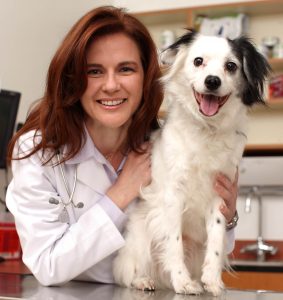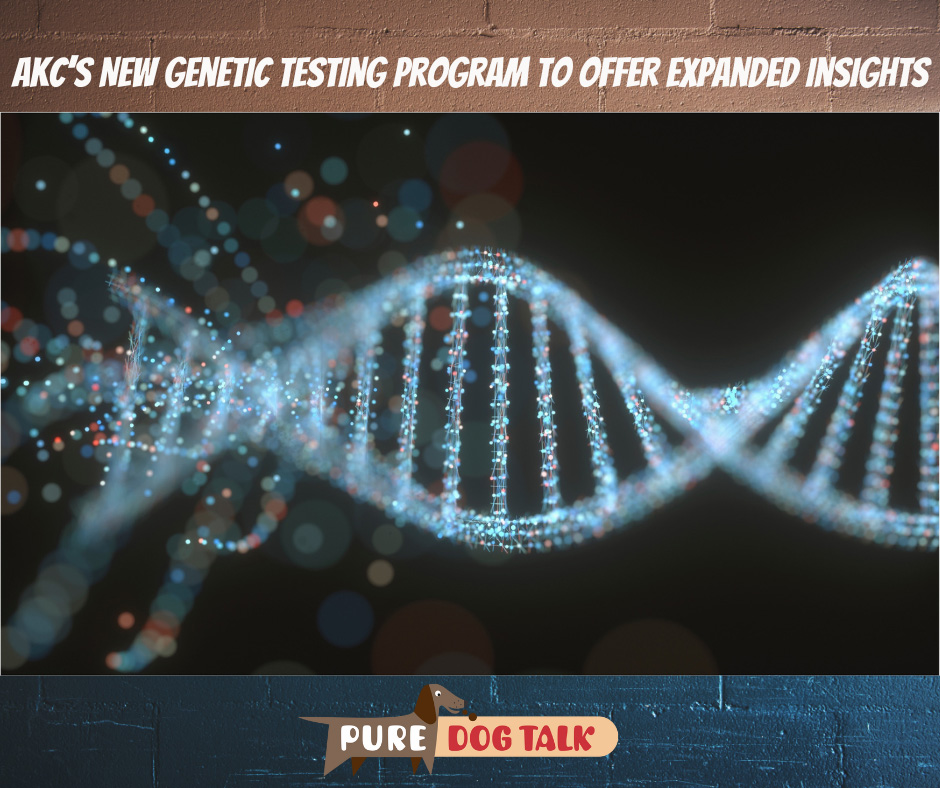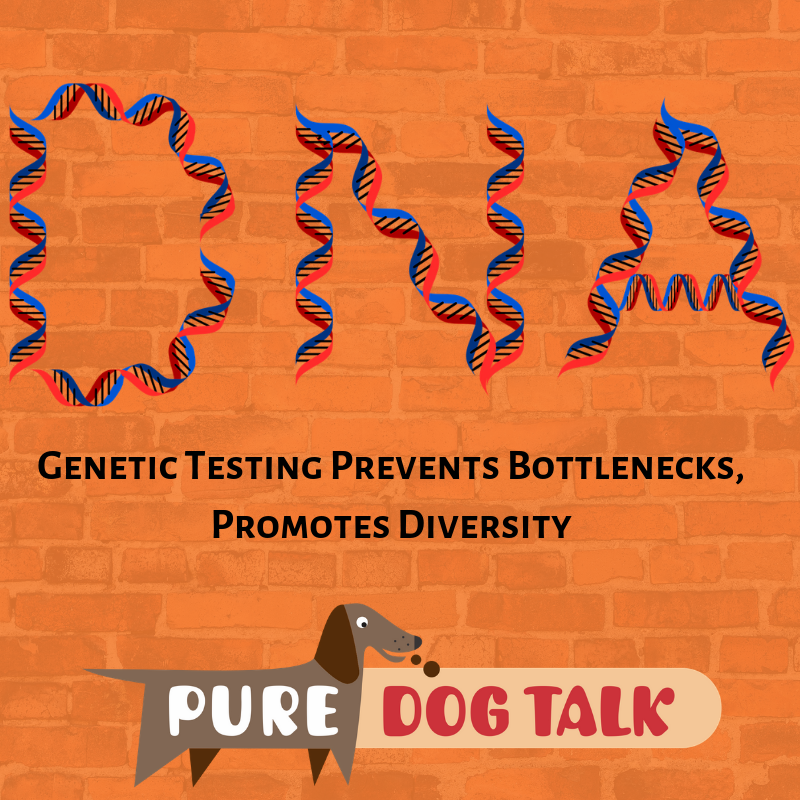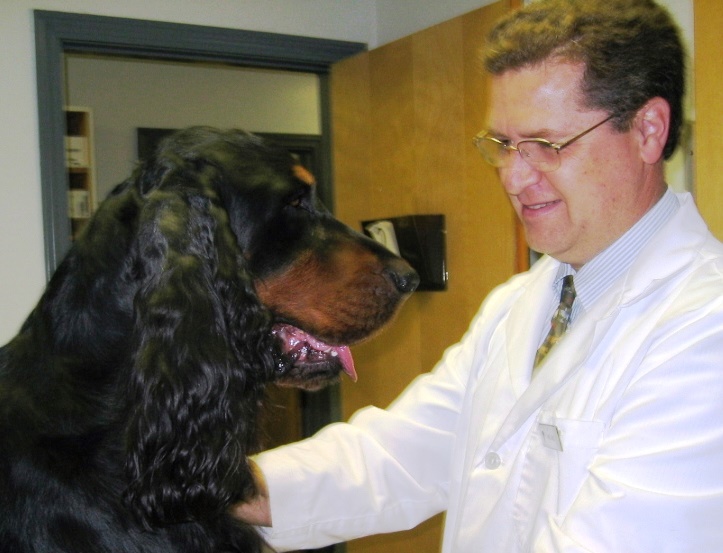568 – AKC’s New Genetic Testing Program to Offer Expanded Insights
AKC’s New Genetic Testing Program to Offer Expanded Insights

Dr. Claire Wiley, VMD and her Portugese Water Dog.
Dr. Claire Wiley, Executive Director of the AKC DNA Program, joins host Laura Reeves with breaking news about the expansion of their testing capabilities.
AKC’s DNA program will soon include the option to identify traits and genetic diseases, in addition to simple parentage, Wiley announced.
“For the past 25 years, the AKC DNA program has really focused on protecting the registry,” Wiley noted. “And they did that using unique identification, kind of like fingerprints and also using those fingerprints to verify parentage. It had more of a regulatory role to it.
“A couple years ago, the AKC developed an ad hoc genetics committee. They listened to the breeders (who) were really interested in having more from the DNA program. And that’s kind of why I got hired, because we’ve listened to the feedback and are trying to bring things into the future to really serve our most important constituents, the breeder.”
Wiley, a second-generation Portugese Water Dog breeder, is a board certified veterinary specialist in Small Animal Internal Medicine. Her passion for genetic health testing started early in life after losing two PWD puppies to juvenile dilated cardiomyopathy. She later worked on the breakthrough studies to identify the genetic marker for protein losing nephropathy in Soft Coated Wheaten Terriers.
“I’m a breeder. I lived through it from the very beginning and now I’m back here to help bring the DNA program into the future,” Wiley said. “At AKC, we try to focus on all dog owners, but it all starts with the breeders who are producing the healthy dogs for all dog owners.
“The fundamental process will essentially be the same where you use a cheek swab to collect DNA and you go online to activate it. When you first go in to buy the swabs, there will be two products. The original parentage product will be called the AKC Original DNA profile and then the one that includes health tests and traits will be called the AKC Signature DNA profile.
“So when you’re actually on what we call our shop page where you’re buying the swabs, you have an option of choosing either just the Original profile, which is the $50 kit that provides parentage, or you can choose the option that still includes that $50 original profile, but also has health and traits available.
“We’re really hoping to launch this by mid 2023 at the latest, hopefully April. A lot of these companies say there are over 200 markers that they’re testing for, but if you actually talk to breeders, they’re probably focused on 2, 3, maybe 0 for that specific breed. So, we are taking the experts, you know, the Breeders, and having them tell us what we should be including as important markers for them.
“The parent clubs have what we call parent club health statement letters where they actually say this is what we are concerned about as a breed and as a group, and so we’re using those letters to determine which testing is the most important for that breed.”
Listen to the full episode for more from Dr. Wiley.
426 – Love is in the Air: Genetic Testing Offers “MatchMaking”
Love is in the Air: Genetic Testing Offers “MatchMaking”
Adam Boyko, chief science officer at Embark, joins host Laura Reeves for a science geek out session.
“There’s really three important reasons to do genetic testing,” Boyko said. “The first is the health component that you get from genetic testing. In almost every purebred breed there are inherited disorders we can test for today. It’s good to get that peace of mind. It’s good to know if a dog is a carrier for something if you’re planning on breeding it. It’s good (for owners) to know if it’s at risk or something so you know what to look out for, if there’s a special diet you should be feeding it or what sort of environment you should have that dog in.
“Secondarily, you’ve got genetic traits, which scientists have learned a lot about. So, you might want to know what sort of coat colors the dog carries. If you were to breed it what would you expect the litter proportions to be. It’s also coat type, stature all that kind of stuff.
“Finally, inbreeding. Breeders have really been interested in (this) a lot. They’ve been traditionally using pedigree-based methods to (measure COI), but now that we have genomic information you can actually much, much more accurately measure inbreeding, to predict inbreeding of different crosses and see the affect that inbreeding has on the health and longevity of dogs. (It’s) another breeding decision that breeders use, another metric, as they’re trying to balance all the different things.”
Embark’s new “Matchmaker” tool is now online for select breeds, which allows breeders to select different combinations to determine which one offers the lowest COI, which dog carries or doesn’t for which traits or diseases, and would therefore offer the breeder the ideal mating they are seeking.
Visit Embark’s website for more information on services available for your breeding program.
237 — DNA Genetic Testing Prevents Bottlenecks, Promotes Diversity
DNA testing can provide useful information for all breeders

Angela Hughes DVM PhD, Veterinary Genetics Research Manager, Wisdom Health
Testing our dogs’ DNA provides details on everything from ancestry in mixed breeds to disease mutations and genetic diversity in purebred dogs. Dr. Angela Hughes, Veterinary Genetics Research Manager at Wisdom Health, talks about the different types of DNA genetic testing.
“A breed is a specific combination of alleles,” Hughes said. “And 99 percent of the DNA in a Great Dane is the same as a Chihuahua. It’s that one percent that is so important.”
DNA Panel tests, Hughes said, test for genetic mutations. The Wisdom Health Optimal Selection panel tests for 180 different specific diseases that are broken out by which are identified and correlated within each breed.
Focus on genetic diversity.
“Studies show that losing genetic diversity causes loss of reproductive health, increased disease incidence, even decreased hunting ability,” Hughes said.
Purebred dog breeders are succeeding with test and replace breeding theories, Hughes believes. She referenced a study of dogs in the U.S., mixed breed and purebred, in which of all diseases tested for, 34 disorders were found only in mixed breeds, not in purebred dogs.
While Hughes acknowledges that “you can have healthy highly inbred dogs,” she notes that breeders have to be incredibly selective to achieve that.
“The average breeder doesn’t have the time and resources, the number of dogs necessary or enough information to be that highly selective,” Hughes said.
Genetic diversity in dogs will be different even in full siblings, Hughes said. For full littermates, on average, about 50 percent of the DNA is the same. This power of DNA testing, Hughes noted, is that it can help identify which of two dogs, similar in quality and pedigree, is the best match in terms of genetic diversity. Simple pedigree analysis and COI (coefficient of inbreeding) can’t provide that information.
Skip the Bottleneck
The diversity testing also helps avoid bottlenecks in a breed’s gene pool due to popular sire syndrome. She defines this as any sire with more than 100 puppies produced. In an example based on studies of Golden Retrievers in England, in a gene pool of six generations, with 31,259 individual animals represented, the testing revealed only 67 genetically unique individuals.
“DNA testing doesn’t tell you who to breed, it tells you who to breed to,” Hughes reiterated. “This is the last piece. Do all the other testing – conformation, temperament, health, function – then do this.”
Importantly, Hughes also noted that breeders should be careful to not lose the “essence of the breed” in search of genetic diversity.
“You want to move the needle,” Hughes said. “Just shift the curve in the direction of diversity.”
https://www.optimal-selection.com/
164 – Busting the Genetic Testing Myths: Dr. Jerold Bell|Pure Dog Talk
Stick around for input from Allison Foley at the Leading Edge Dog Show Academy about tips for successfully using a flat iron to groom drop-coated dogs.
And take a minute to stop by https://blog.feedspot.com/dog_podcasts/ and check out the top 15 dog podcasts! Of which we are one!
164 – Busting the Genetic Testing Myths: Dr. Jerold Bell
BUSTING THE GENETICS MYTHS: DR JEROLD BELL
Last week we talked with Dr. Marty Greer about health testing 101. This week we’re taking the graduate course in genetics with Dr. Jerold Bell from Tufts University’s Cummings School of Veterinary Medicine.
Bell has some serious myth busting going on in this discussion that I think our listeners are going to enjoy.
MIXED BREEDS ARE NOT HEALTHIER
First of all, mixed breeds are not healthier than purebred dogs.
“The most frequent genetic disorders that we see in practice are seen equally between purebreds and mixed breeds,” Bell said.
Second, there is a heritability factor in many diseases we had not previously considered. Bell talks specifically about studiesindicating even something as seemingly obviously traumatic as cruciate ligament tears have a genetic component.
Third, all breeders should be health testing their dogs. The increasing number of DNA tests available enables breeds with simple recessive gene pairs creating disease to quickly and easily apply positive pressure to the pedigree. Breeding a quality carrier status animal to a clear, then breeding the resulting quality clear offspring, Bell said, will rapidly eliminate diseases such as a specific form of Progressive Retinal Atrophy.
“And that’s really the take home message for today,” Bell said. “Is that anyone that’s doing breeding must be doing breed specific genetic testing of the parents and if they’re not doing that then they should not be breeding. Then they are not an ethical breeder and not a health conscious breeder and there’s no place today for breeders that are not going to do that.”
Fourth, for complex inherited diseases, in which a combination of genes is causing a disease process to be expressed, the OFA/CHIC database offers the opportunity to research a “vertical pedigree” to study the incidence of disease in the entire family of the dogs being considered for breeding.
OFA IS FACEBOOK FOR DOGS
“So when you look up at dog’s web page on the OFA Website,” Bell said, “and this is Facebook for dogs, this is the dog’s own individual website. They can have their picture on there, it has all their information. It has all the information of the tests results from the parents from the siblings from the half siblings. … even in a normal individual that you’re looking at for breeding, if the parents or the parents’ siblings (indicate) more disease present, it tells you that you’re going to have a greater genetic load of liability genes for that particular disorder.”
Finally, using health testing *appropriately* is mission-critical. Bell noted that breeders’ selection processes should emphasize only those diseases which are of concern within their respective breeds. He presented an outstanding webinar for the AKC Canine Health Foundation available here which goes into even greater detail on this topic.
“…people might say that because (our dogs) purebred they have limited diversity and therefore they’re unhealthy,” Bell said. “And that is not true.’
We hope you enjoy this very rich conversation with Dr. Bell and are able to apply this knowledge in your own breeding programs.




